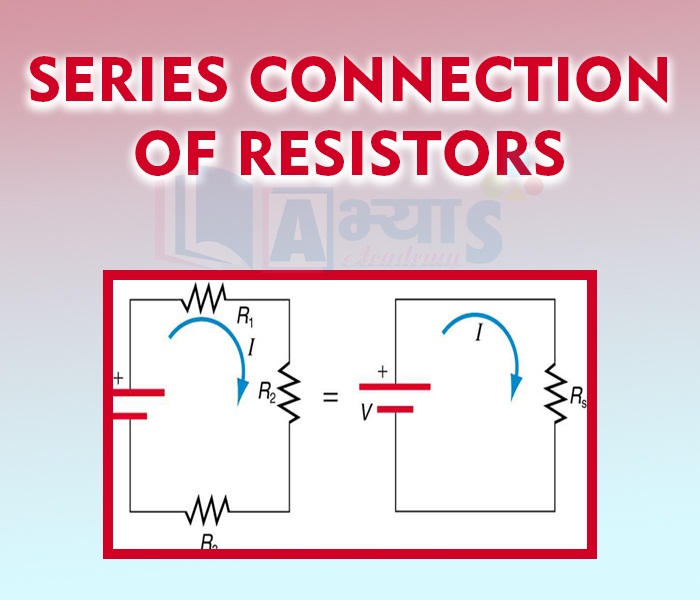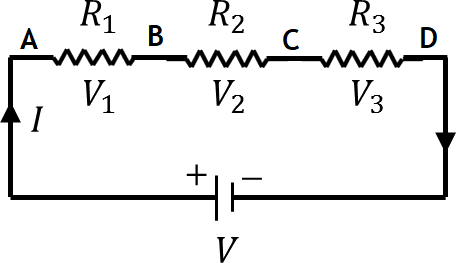Series Connection of Resistors










Series Connection of Resistors
Combination of Resistance:
In many applications to get a required value of resistance two or more resistances are combined. Two or more resistance can be combined in more than one way.
1. Series Combination
2. Parallel Combination
If, in an electrical circuit, two or more resistances connected between two points are replaced by a single resistance such that there is no change in the current of the circuit and in the potential difference between those two points, then the single resistance is called the 'equivalent resistance. When the resistance of a circuit is to be increased, they are combined in series and when heavy current is to be passed they are combined in parallel so as to decrease the total resistance.
Series Combination of Resistance:
In this combination, the resistances are joined end to end. Thus the second end of each resistance is joined to the first end of the next resistance, and so on. The first end of the first resistance and the second end of the last resistance are connected to the cell. In this combination, the same current flows in all the resistances but the potential differences between their ends are different according to their resistances.
In this combination more than one resistance is connected one after the other as shown. In this type of circuit:

1. Equal current flows through each resistance.
2. Total voltage drop across the combination is equal to the sum of voltage drop across each resistance.
3. Voltage drop each resistance can be calculated using Ohm’s Law and is proportional to the value of resistance.
4. Equivalent resistance is thus greater than resistance of any resistor in the circuit.. This is also known as maximum effective resistance
In the circuit given we have three resistance R1, R2 and R3 are connected in series and V1, V2 and V3 are the potential drop across each resistance respectively. If I is the current flowing through the circuit when a cell with potential difference V is applied across them
.......(1)
.......(2)
.......(3)
Now, let us assume a resistance is the equivalent resistance which will have the same potential difference as the combination.
.......(4)
Equivalent resistance can be calculated by using the fact that total potential drop in the circuit is equal to the sum of potential drop across each resistance
.......(5)
Substituting the value from Equations 1, 2, 3, 4 in 5 we get
The sum of individual potential drop across the resistors connected in series is equal to the total potential difference across the series can be derived as follows
Potential difference across point A and B
Potential difference across point B and C ,
Potential difference across Point C and D
On adding the potentials across
i.e. equal to the potential difference between points A and D = V
Disadvantages of Series Combination:
(i) In series combination, if any of the components fail to work, the circuit will break and then none of the components will work.
(ii) It is not possible to connect a bulb and a heater in series because they need different values of current to operate properly. Hence, to overcome this problem we do not use series circuit.
Illustration: Five resistance are connected as shown in the figure below. Calculate current through the circuit, also calculate the potential drop across resistance R5

Solution: In the figure we are given five resistances which are connected in series. To calculate current in the circuit we have to calculate the equivalent resistance.
The equivalent resistance is the sum of individual resistance
A bulb, fan, and a motor each of resistance of 13 ohm,25 ohms and 40 ohms are connected in series.How much potential difference should be applied to make 15A of current to flow through the circuit. | |||
| Right Option : D | |||
| View Explanation | |||
Three bulbs each of resistance of 3 ohm are connected in series are connected to two fans of resistance 5 ohms each.A current of 5A is passing through what will the potential difference applied in the circuit | |||
| Right Option : D | |||
| View Explanation | |||
| Right Option : A | |||
| View Explanation | |||
Students / Parents Reviews [20]
About Abhyas metholodology the teachers are very nice and hardworking toward students.The Centre Head Mrs Anu Sethi is also a brilliant teacher.Abhyas has taught me how to overcome problems and has always taken my doubts and suppoeted me.

Shreya Shrivastava
8thAbhyas academy is great place to learn. I have learnt a lot here they have finished my fear of not answering.It has created a habit of self studying in me.The teachers here are very supportive and helpful. Earlier my maths and science was good but now it has been much better than before.

Barkha Arora
10thMy experience with Abhyas academy is very good. I did not think that my every subject coming here will be so strong. The main thing is that the online tests had made me learn here more things.

Hiya Gupta
8thWhen I have not joined Abhyas Academy, my skills of solving maths problems were not clear. But, after joining it, my skills have been developed and my concepts of science and SST are very well. I also came to know about other subjects such as vedic maths and reasoning.

Sharandeep Singh
7thA marvelous experience with Abhyas. I am glad to share that my ward has achieved more than enough at the Ambala ABHYAS centre. Years have passed on and more and more he has gained. May the centre flourish and develop day by day by the grace of God.

Archit Segal
7thBeing a parent, I saw my daughter improvement in her studies by seeing a good result in all day to day compititive exam TMO, NSO, IEO etc and as well as studies. I have got a fruitful result from my daughter.

Prisha Gupta
8thIt was a good experience with Abhyas Academy. I even faced problems in starting but slowly and steadily overcomed. Especially reasoning classes helped me a lot.

Cheshta
10thMy experience was very good with Abhyas academy. I am studying here from 6th class and I am satisfied by its results in my life. I improved a lot here ahead of school syllabus.

Ayan Ghosh
8thMy experience with Abhyas academy is very nice or it can be said wonderful. I have been studying here from seven class. I have been completing my journey of three years. I am tinking that I should join Abhyas Academy in tenth class as I am seeing much improvement in Maths and English

Hridey Preet
9thWe started with lot of hope that Abhyas will help in better understnding of complex topics of highers classes. we are not disappointed with the progress our child has made after attending Abhyas. Though need to mention that we expected a lot more. On a scale of 1-10, we would give may be 7.

Manya
8thMy experience with Abhyas Academy has been very good. When I was not in Abhyas whenever teacher ask questions I could not speak it confidently but when I came in Abhyas, my speaking skills developed and now I am the first one to give the answer of teachers question.

Upmanyu Sharma
7thUsually we see institutes offering objective based learning which usually causes a lag behind in subjective examinations which is the pattern followed by schools. I think it is really a work of planning to make us students grab the advantages of modes of examination, Objective Subjective and Onli...

Anika Saxena
8thIt was good as the experience because as we had come here we had been improved in a such envirnment created here.Extra is taught which is beneficial for future.

Eshan Arora
8thAbhyas Methodology is very good. It is based on according to student and each child manages accordingly to its properly. Methodology has improved the abilities of students to shine them in future.

Manish Kumar
10thThird consective year,my ward is in Abhyas with nice experience of admin and transport support.Educational standard of the institute recumbent at satisfactory level. One thing would live to bring in notice that last year study books was distributed after half of the session was over,though study ...

Ayan Ghosh
8thI have spent a wonderful time in Abhyas academy. It has made my reasoning more apt, English more stronger and Maths an interesting subject for me. It has given me a habbit of self studying

Yatharthi Sharma
10thOne of the best institutes to develope a child interest in studies.Provides SST and English knowledge also unlike other institutes. Teachers are co operative and friendly online tests andPPT develope practical knowledge also.

Aman Kumar Shrivastava
10thAbhyas is good institution and a innovative institute also. It is a good platform of beginners.Due to Abhyas,he has got knoweledge about reasoning and confidence.My son has improved his vocabulary because of Abhyas.Teacher have very friendly atmosphere also.

Manish Kumar
10thAbhyas institute is one of the best coaching institute in the vicinity of Ambala Cantt area. The teachers of the institute are well experienced and very helpful in solving the problems of the students.The good thing of the institute is that it is providing extra classes for the students who are w...

Aman Kumar Shrivastava
10thThe experience was nice. I studied here for three years and saw a tremendous change in myself. I started liking subjects like English and SST which earlier I ran from. Extra knowledge gave me confidence to overcome competitive exams. One of the best institutes for secondary education.
